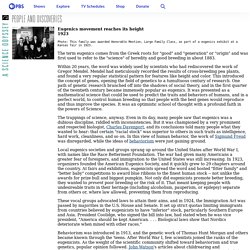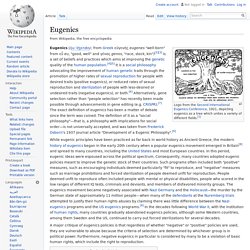Zoom
Trash
Related: AGENDA 21-30
- Silent Depopulation
- Eugenics
- PRIVACY INFRINGEMENT
- Education
- Enterprise

The plot to create Britain’s super race. Among them was five-year-old Juliet Phelps Brown, now Juliet Hopkins, whose parents were convinced that Britain was about “to become a province of Germany” and who could not countenance living in such a place: “How could academics live with people who burned books?”

Now 77 and herself an accomplished academic still teaching in her specialist area of child psychotherapy, Hopkins remembers standing on the deck as the ship pulled out into the Mersey, holding the hand of a three-year-old girl who needed consoling after she had dropped her teddy bear over the side. “It was a dreadful voyage,” she says. “Everyone was very seasick.” And no one had any idea when they would be coming back. In this, they were not so unique. Among those who saw out the war in North America were the future Shirley Williams, as well as Martin Gilbert, later to become Winston Churchill’s official biographer, Eric Hammond, later a combative trades union leader, novelist Lynne Reid Banks and a couple of Bonham Carters.
History, Travel, Arts, Science, People, Places. History, Travel, Arts, Science, People, Places. Sterilization Abuse in State Prisons: Time to Break With California's Long Eugenic Patterns This post was co-authored with Tony Platt The recent revelation that 148 female prisoners in two California institutions were sterilized between 2006 and 2010 is another example of the state's long history of reproductive injustice and the ongoing legacy of eugenics.

A Science Odyssey: People and Discoveries: Eugenics movement reaches its height. Eugenics movement reaches its height1923 Photo: This family was awarded Honorable Mention, Large Family Class, as part of a eugenics exhibit at a Kansas fair in 1923.

The term eugenics comes from the Greek roots for "good" and "generation" or "origin" and was first used to refer to the "science" of heredity and good breeding in about 1883. Within 20 years, the word was widely used by scientists who had rediscovered the work of Gregor Mendel. Mendel had meticulously recorded the results of cross-breeding pea plants, and found a very regular statistical pattern for features like height and color. This introduced the concept of genes, opening the field of genetics to a tumultuous century of research. The trappings of science, anyway. Local eugenics societies and groups sprang up around the United States after World War I, with names like the Race Betterment Foundation.
The Horrifying American Roots of Nazi Eugenics. Hitler and his henchmen victimized an entire continent and exterminated millions in his quest for a co-called "Master Race.

" But the concept of a white, blond-haired, blue-eyed master Nordic race didn't originate with Hitler. The idea was created in the United States, and cultivated in California, decades before Hitler came to power. California eugenicists played an important, although little known, role in the American eugenics movement's campaign for ethnic cleansing. Eugenics was the racist pseudoscience determined to wipe away all human beings deemed "unfit," preserving only those who conformed to a Nordic stereotype. Elements of the philosophy were enshrined as national policy by forced sterilization and segregation laws, as well as marriage restrictions, enacted in twenty-seven states.
California was considered an epicenter of the American eugenics movement. Eugenics was born as a scientific curiosity in the Victorian age. How? Hitler studied American eugenics laws. Eugenics. While eugenic principles have been practiced as far back in world history as Ancient Greece, the modern history of eugenics began in the early 20th century when a popular eugenics movement emerged in Britain[8] and spread to many countries, including the United States and most European countries.

In this period, eugenic ideas were espoused across the political spectrum. Consequently, many countries adopted eugenic policies meant to improve the genetic stock of their countries. Such programs often included both "positive" measures, such as encouraging individuals deemed particularly "fit" to reproduce, and "negative" measures such as marriage prohibitions and forced sterilization of people deemed unfit for reproduction. People deemed unfit to reproduce often included people with mental or physical disabilities, people who scored in the low ranges of different IQ tests, criminals and deviants, and members of disfavored minority groups.
History[edit] Some, such as Nathaniel C. Ethics[edit]